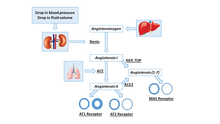Angiotensin (1-7)
It has been suggested that talfirastide be merged into this article. (Discuss) Proposed since December 2023. |
| Angiotensin (1-7) | |
|---|---|
Angiotensin (1-7) (C
41H
62N
12O
11; Molecular weight = 899.02 g/mol; H-
In 1988, Santos et al demonstrated that angiotensin (1-7) was a main product of the incubation of angiotensin I with brain micropunch biopsies[1] and Schiavone et al reported the first biological effect of this heptapeptide.[2]
Angiotensin (1-7) is a vasodilator agent affecting cardiovascular organs, such as heart, blood vessels and kidneys, with functions frequently opposed to those attributed to the major effector component of the RAS, angiotensin II (Ang II).[3]
Synthesis
The polypeptide Ang I can be converted into Ang (1-7) by the actions of

Possible pathways
- Action of neprilysin on angiotensin I or angiotensin II.
- Action of angiotensin I.
- Action of ACE on angiotensin 1-9.
- Action of neprilysin on angiotensin 1-9.
- Action of angiotensin II.
Effects
Ang (1-7) has been shown to have anti-oxidant and anti-inflammatory effects.[7][8] It helps protect cardiomyocytes of spontaneously hypertensive rats by increasing the expression of endothelial and neuronal nitric oxide synthase enzymes, augmenting production of nitric oxide.[9]
Pharmacological interactions
Ang (1-7) contributes to the beneficial effects of ACE inhibitors and angiotensin II receptor type 1 antagonists.[10]
